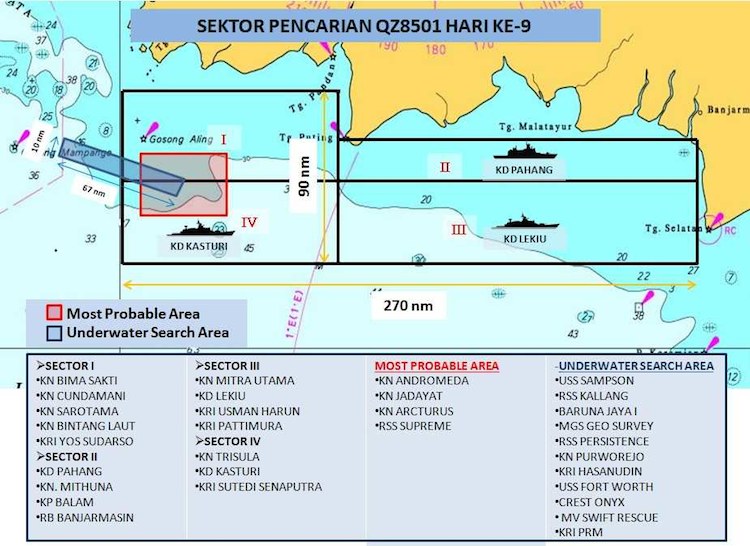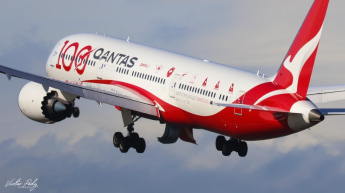On the ninth day since Indonesia AirAsia flight QZ8501 was lost from radar contact between Singapore and Surabaya, a total of five large pieces of hypothetical aircraft wreckage and 30 bodies are all that the Indonesia-led international search and recovery effort has been located.
The “big parts”, as search and rescue agency BASARNAS chief Bambang Soelistyo calls them, remain with an unknown number of passengers inside them in between 20 and 30 metres of water to the southwest of Pangkalan Bun on the island of Borneo. Over 30 military and merchant naval vessels are currently engaged in the search, with a dozen focussing on a 2300 square kilometre box, the Underwater Search Area, to the west.
Unexplained significant changes to the operation’s Most Probable Area
For Monday January 5, the overall size of the search sector has been extended eastwards, and now covers an area 270 nm (500 km) wide, “in view of the easterly direction of the current at the rate of 1 knot” according to Malaysian Chief of Navy Admiral Abdul Aziz Jaafar.

More striking, however, is the return of the Most Probable Area to the western end of the search zone, to an area almost identical in location and size to Saturday’s, while Sunday’s had shifted east by hundreds of kilometres and expanded by approximately 200 per cent.
Australian Aviation has asked Admiral Abdul Aziz Jaafar, who provided the images and information, for confirmation of the shift and reasoning behind it, but the Admiral has yet to respond.
Indonesia appears unprepared for routine seasonal weather SAR operations
Eight days on from the crash, writing that wind, rain and seas have once again hampered the search is becoming a cliché. A report from The Age’s Indonesia Correspondent Michael Bachelard (note: autoplay video) and this release from the Republic of Singapore Air Force give an idea of the conditions.
While the weather conditions are challenging, especially for towed-sonar and diving operations, they are by no means unusual for the time of year in the Inter-Tropical Convergence Zone (ITCZ).
Questions need to be asked – perhaps under the auspices of the International Maritime Organisation (IMO) and International Civil Aviation Organisation (ICAO) – about whether Indonesian authorities have suitable SAR equipment to operate year-round in the extensive area for which Indonesia has SAR responsibility.

More leaks damage Indonesian credibility and may prejudice the investigation
Leaked investigation materials have resulted in media speculation that pilots may not have had access to the latest weather conditions from Indonesia’s Meteorology, Climatology and Geophysics Agency (BMKG).
Australian Aviation has asked BMKG to confirm:
1) what aviation weather forecast products it routinely provides to Indonesia AirAsia and other flights departing Surabaya, and the nature of those products
2) when those products are created, when and how they are delivered to Indonesia AirAsia and other airlines, and what the exact timetables were on 27, 28 and 29 December 2014.
3) which weather products it believes that the pilots of Indonesia Air Asia flight QZ8501 on 28 December did not access before departure
BMKG has not yet responded to our queries.
Regardless of the facts of the matter, the leaked materials, from BMKG to Transportation Minister Ignatius Jonan, do nothing for the credibility of Indonesia’s investigation, and the ongoing information flow of BMKG material is deeply inappropriate.
That’s particularly true given that BMKG is an organisation which will certainly be called to give evidence to the investigation, and which has responsibility for predicting the weather that it itself has fingered as the cause of the accident.
Leaks also appear to be against Indonesian law
In addition to potentially prejudicing the investigation, continuing leaks of information are also likely to be unlawful, in violation of Indonesia’s Civil Aviation Safety Regulations, particularly Part 830, which covers “notification and reporting of aircraft accidents or serious incidents and accident or serious incident investigation procedures”.
Part 830.17, “Flow and dissemination of accident information”, reads:
a. Release of information during the field investigation, particularly at the accident/serious incident scene, shall be limited to factual developments, and shall be made only through the NTSC [National Transportation Safety Committee] or DGCA [Directorate General of Civil Aviation] representative present at the accident/serious incident scene, the representative of the NTSC’s or DGCA’s Office of Public Affairs, or the investigator-in-charge.
b. All information concerning the accident obtained by any person or organization participating in the investigation shall be passed to the IIC [Investigator In Charge] through appropriate channels before being provided to any individual outside the investigation. Parties to the investigation may relay to their respective organizations information necessary for purposes of prevention or remedial action.
c. Accident information should not be passed on to people who are not participants, participant organizations and employee representatives are not participants prior to the initial announcement by the NTSC without the approval of the IIC.
AirAsia’s English releases are a counterpoint to official Bahasa-only policy
In contrast to the investigation’s release of information almost exclusively in Bahasa Indonesia and not in either English or one of the other five working languages of the International Civil Aviation Organization, ICAO (Arabic, Chinese, French, Russian or Spanish), AirAsia is releasing information in English, including a press release overnight that includes this admonition:
“AirAsia would like to take this opportunity to urge the public seeking progress on the search and evacuation and identification process of QZ8501 passengers to refer solely to official information from BASARNAS and DVI Polri [the Disaster Victim Identification section of the Indonesian Police],” yet information from the Indonesian authorites is being released almost exclusively on site – where it is clear the subject matter expertise among attending media is lacking – and often only in Bahasa Indonesia.
At this point in the recovery and investigation, it is remarkable that Indonesian authorities have not accepted at least public affairs assistance and technical translation aid into one or more of the working languages of ICAO.
Australian Aviation asked the ATSB (which redirected our enquiry to DFAT) for details of what investigative and other ATSB assets have been offered to Indonesia. An Australian government spokesperson confirmed the two AP-3C Orion aircraft that participated in the early stages of the search, but referred to no further hardware assets. “On Sunday 4 January the Australian Federal Police (AFP) deployed three Disaster Victim Identification personnel and two civilian forensics experts. ATSB has agreed to an Indonesian request to provide a flight recorder specialist when needed.”
The Australian government spokesperson did not answer Australian Aviation’s questions on whether search and investigation assets had been offered but declined, on the last time Indonesian search officials had made requests to ATSB, and in particular whether Australia had offered vessels with heavy sea state capabilities.
While the recovery and investigation are Indonesian operations in Indonesian waters and the Indonesian SAR area, the way that Indonesia conducts them will affect Indonesia’s standing in the civil aviation world.
Numerous international SAR and air accident investigation organisations have offered their assistance to BASARNAS, air accident investigator NTSC and other Indonesian bodies. Not accepting assistance in this field, while consistently making errors and conducting the investigation in a way that precludes international transparency, would seem at the very least deeply unwise for a government and aviation regulator with a poor reputation even before the crash of QZ8501.















Adrian Paddington
says:I think this article is more worthy of a tabloid newspaper rather than a specialist magazine.
Perhaps the reason Australian Aviation magazine has not received an answer from Indonesia’s Meteorology, Climatology and Geophysics Agency (BMKG) is Part 830.17, “Flow and dissemination of accident information”.
As for accepting international help didn’t some Russian divers with specialist equipment recently arrive on a Beriev Be-200.
What I have liked about this operation is that the Indonesian politicians have kept out it allowing their authorities to deal with the media unlike MH17 and MH370 where some politicians were far to keen to grab a microphone to pass on unverified/incomplete information.
Toni Blackmore
says:Disagree with previous commenter, this is a Titan of a piece! John, I felt (ridiculously and narcissistically) rebuffed when RAF assets summarily dismissed at the first “confirmed report” of an upside down aircraft shadow. Would be interested to know if ID’s actually declined offers of help with this SAR phase though. More strength to your arm!
David Carter
says:Every journalist knows there is a pecking order for the flow of information. For an Indonesian plane that crashed in Indonesia killing many Indonesians, the pecking order is both heavy at the top with Indonesians and long. An email from an obscure Australian publication demanding complex and possibly embarrassing answers isn’t going to survive the delete button. John could better spend his time chasing Airbus about why two of its products have now fallen from the sky in severe tropic weather. Ice affecting sensors, incorrectly programmed autopilots, pilots disorientated and confused by the data being presented on their instruments, inadequate training of air crew? These are the aviation questions, not the failings of Indonesia’s search and recovery efforts.
Gaby
says:I rather agree with Adrian, the article has a patronising tone and is not up to Australian Aviation’s standards as a professional magazine. Just because perhaps it is not done in Indonesia like it is in London/New York/Paris doesn’t mean they are incompetent. Indonesia is a sprawling third world country with a large population and whilst no doubt having its share of issues, so do we all. One really needs to look at the problen through the limited resources a country like Indonesia has.
…. or perhaps one of our navy ships, with the best positioning technology in the world, can ‘accidently’ cross into their teritorial waters and show then how professionals do it.
Garry
says:We sent the PC’s home to quick, regarding the media its time they should be accountable for MISS INFORMATION., always want to grab a headline